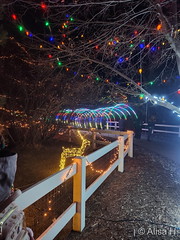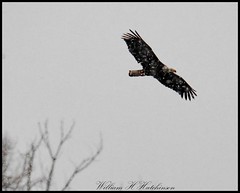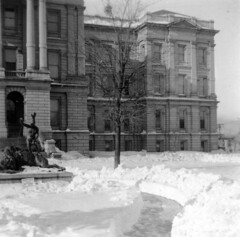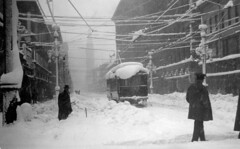One of our coldest and driest months, January is not normally known for its weather extremes. However just like any in Colorado, significant events can occur as we see in our look back at this week in Denver weather history.
From the National Weather Service:
25-31
In 1980…temperatures were unusually warm during the week between Christmas and New Year’s. High temperatures for the week ranged from the mid-50’s to the mid-70’s. Four temperature records were set. Record highs occurred on the 26th with 68 degrees…the 27th with 75 degrees…and the 30th with 71 degrees. A record high minimum temperature of 41 degrees occurred on the 27th.
30-31
In 1886…heavy snow totaled 6.5 inches in downtown Denver. Most of the snow…4.5 inches…fell on the 31st. North winds were sustained to 18 mph.
In 1928…snowfall of 0.6 inch was the only measurable snow of the month in the city.
In 1947…post-frontal heavy snow totaled 6.3 inches over downtown Denver. Most of the snow fell on the 30th. North winds were sustained to 17 mph on the 30th.
In 1995…the foothills west of Denver received 5 to 9 inches of new snow…except for Bailey where 11 inches of snow were measured. No snow fell at the site of the former Stapleton International Airport.
In 2021…the first significant snowfall of the season finally made its mark…impacting the mountains…foothills…and nearby plains with much needed moisture. In the mountains and foothills…storm totals ranged from 6 to 15 inches. Elsewhere 5 to 10 inches of snow fell west of I-25…with 3 to 7 inches east of the interstate. At Denver International Airport…4.5 inches of snow was observed.
31
In 1890…northeast winds were sustained to 46 mph with gusts as high as 60 mph behind an apparent cold front. A trace of sleet fell.
In 1899…northwest winds were sustained to 44 mph with gusts as high as 48 mph. The Chinook winds warmed the temperature to a high of 49 degrees.
In 1927…the temperature was below zero all day. The high temperature of 3 degrees below zero was a record low maximum for the date. The low temperature was 11 degrees below zero.
In 1970…warm Chinook winds whistled through Boulder. A wind gust to 92 mph was recorded at the National Center for Atmospheric Research…while at the National Bureau of Standards…winds peaked to 70 mph. Northwest winds gusting to 30 mph warmed the temperature to a high of 60 degrees at Stapleton International Airport.
In 1993…occasional high winds occurred northwest of Denver and in the foothills. A wind gust to 85 mph was recorded at Jefferson County Airport in Broomfield. Wind gusts to 86 mph occurred on Squaw Mountain with 75 mph recorded at Rollinsville. West winds gusted to 46 mph at Stapleton International Airport.
In 2011…an intense and fast moving storm system… produced a powerful windstorm across the Front Range. In the mountains and foothills…several locations recorded wind gusts in excess of 100 mph. Numerous trees were knocked down throughout Arapahoe National Forest. One man was killed when he was impaled by a falling tree limb while driving along U.S. Highway 36…north of Boulder. The strong winds produced extensive damage to fences and roofs… and also knocked down trees which resulted in power outages that affected 19 thousand residents along the Front Range. In the mountains and foothills…peak wind gusts included: 111 mph…3 miles south-southeast of Pinecliffe; 101 mph…1 mile west of Lyons; 94 mph atop Berthoud Pass; 86 mph…3 miles south of Golden; 84 mph… 4 miles northwest of Boulder; 81 mph in Boulder; 79 mph at Kenosha Pass…NCAR Mesa Lab and the junction of U.S. Highways 72 and 93; 77 mph at the National Wind Technology Center; and 76 mph…3 miles north-northwest of Morrison. Peak wind gusts for the Urban Corridor included: 80 mph…3 mile east of Cedar Point; 77 mph in north Longmont; 67 mph…10 miles east of Parker; 64 mph at Buckley AFB and Lakewood; 60 mph at Bennett and Front Range Airport in Watkins; 59 mph at Denver International Airport and Deer Trail; 58 mph at Rocky Mountain Regional Airport in Broomfield and 2 miles north-northwest of Louisville.
In 2021…much of the Front Range Foothills…Urban Corridor and adjacent plains were classified to be in severe to extreme drought (D2/D3) through the month of December. These conditions contributed significantly to the Marshall Wildfire…the costliest fire in Colorado history. The Front Range experienced a very wet first half of the year…with well above normal precipitation and lush…tall grass growth. However…starting around July…a persistently dry weather pattern set up and held firm through the entire fall and early winter. Vegetation…while typically dry this time of year…was exceptionally dry as very little precipitation had fallen through the entire fall season. The ongoing drought conditions ensured larger fuels such as shrubs and trees were likewise critically dry. From the period of July 1st through December 29th…temperature and precipitation climate records showed Denver was the 2nd warmest…and by far the driest in recorded history…since 1872. Boulder was ranked as 2nd warmest for precipitation…while 13th driest in recorded history.
31-1
In 1900…low temperatures dipped to 19 degrees below zero on both days to establish daily record minimum temperatures.
In 1975…only 4.2 inches of snow fell at Stapleton International Airport…while north of Denver a major blizzard raged. All roads north of Denver into Wyoming were closed when strong winds whipped snow into 5 to 6 foot drifts. North winds gusted to 43 mph at Stapleton International Airport on the 31st…causing some blowing snow. Freezing drizzle also fell on the 31st.
In 1984…heavy snow fell in the foothills with 8 inches at Boulder and 6 inches in southern and western metro Denver. Only 1.5 inches of snow fell overnight at Stapleton International Airport.
In 1991…a New Year’s Eve snow storm dumped 2 to 8 inches of snow across northeastern Colorado. Snowfall totaled 3.4 inches at Stapleton International Airport. The 1.9 inches of snow that fell on the 31st was the only measurable snowfall of the month.
In 2008…another brief period of high winds occurred in and near the foothills of Boulder and Jefferson counties. In Nederland…the strong wind snapped a blue spruce which landed on a nearby propane tank. Some roofs in the immediate area were damaged and power lines were downed; which left 126 residences without electricity for six hours. Peak wind gusts included 90 mph at the national wind technology center…and 89 mph; 6 miles northwest of Boulder. At Denver International Airport…a peak wind gust of 23 mph was measured from the southwest.
31-6
In 1973…the 31st marked the start of a protracted cold spell that extended into January of 1974 when temperatures dipped below zero on 7 consecutive days. Record daily minimum readings occurred on the 3rd and 5th when the temperature plunged to 17 degrees below zero on both days. A record low daily maximum temperature of only 4 degrees occurred on the 5th.
31-7
In 1941…a protracted cold spell through January 7…1942… Produced below zero low temperatures on 7 of the 8 days. A low temperature of 2 degrees on the 3rd prevented a string of 8 days below zero. The coldest days during the period were the 1st with a high of 2 degrees and a low of 9 degrees below zero…the 4th with a high of 2 degrees and a low of 11 degrees below zero…and the 5th with a high of 26 degrees and a low of 12 degrees below zero.
1
In 1875…the temperature fell 27 degrees between 3:00 pm and 5:00 pm. The high for the day was 43 degrees…and the low was 8 degrees. Occasional snow flurries fell during the day…but not enough to cover the ground.
In 1885…dense smoke choked the skies over downtown Denver until midday.
In 1910…a rare trace of light rain fell during the morning.
In 1911…post-frontal northeast winds were sustained to 40 mph. Only a trace of snow fell in downtown Denver.
In 1952…snowfall of 0.03 inch was the only measurable snowfall of the month and resulted in 0.01 inch of melted snow…the only precipitation of the month.
In 1956…west-northwest winds gusted to 52 mph at Stapleton Airport.
In 1996…the first snow storm of the new year dumped more than a foot of snow in the Front Range foothills with 4 to 9 inches across the western and southern sections of metro Denver. Snow totals included: 14 inches at conifer; 11 inches at Evergreen; and 10 inches at Eldora Ski Resort… West of Boulder. Snowfall totaled only 1.2 inches at the site of the former Stapleton International Airport. North- northeast winds gusted to 30 mph at Denver International Airport.
In 2003…only a trace of snow fell at the site of the former Stapleton International Airport. This…along with a trace of snow on the 22nd…was the only snow of the month…which equaled the 1934 record for the least snowiest January.
1-2
In 1896…warm Chinook winds on the 1st became cold bora winds on the 2nd. Southwest winds sustained to 60 mph with gusts as high as 66 mph warmed the temperature to a high of 55 degrees on the 1st. Northwest winds sustained to 54 mph with gusts to 60 mph resulted in snowfall of 0.3 inch and a high temperature of only 31 degrees on the 2nd.
1-5
In 1940…the first days of the month were characterized by a mixture of drizzle…light snow…and fog. Fog occurred on each day. On the 4th and 5th considerable glazing resulted from freezing drizzle. All objects were coated with a glaze on the windward side. This resulted in very slippery streets…which caused several minor traffic accidents. The glaze was not heavy enough to damage wires and cables. Continue reading December 31 to January 6: This week in Denver weather history




































































